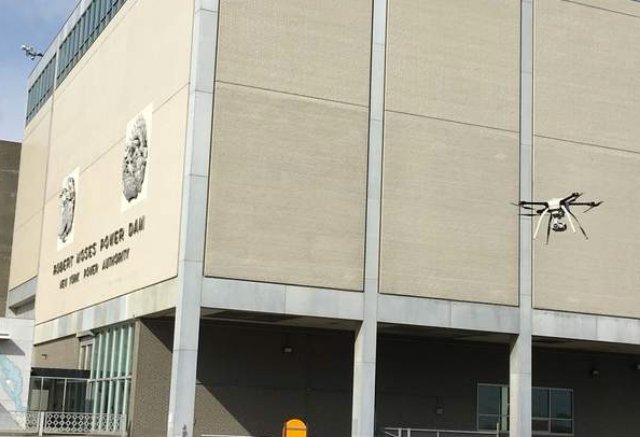Last week, a team from the New York Power Authority joined some Ontario Power Generation representatives to fly a drone around the Robert Moses Dam and St. Lawrence spillway as part of NYPA’s research into launching its own drone inspection program.
“We currently do not own any drones,” said Alan Ettlinger, NYPA’s research, technology development and innovation director.
But, if drones are capable of performing the types of work NYPA would like, the flying objects could become part of the organization’s inventory. NYPA is currently putting specifications together to purchase drones.
“I would say we’ve been looking at it for about a year-and-a-half or so. We’ve been doing various tests. We’re making sure we’re dotting all the I’s and crossing the T’s before we fully implement it. We want to make sure we are safe and sound before we do anything,” Mr. Ettlinger said.
There would be several advantages, he said.
“Using drones to inspect power lines would keep inspectors from having to climb the lines and potentially put themselves in danger. The aircraft could also inspect dams, do post-storm assessments, view vegetation under power lines, and perhaps even be used to secure safety cables for workers climbing towers,” Mr. Ettlinger said.
NYPA is interested in seeing how well the drones perform around transmission lines — if there’s the potential for the drones to be impacted by the line’s electromagnetic forces, he said. The authority is working with the Electric Power Research Institute to conduct those tests.
So far, so good, Ettlinger said, noting they haven’t found any issues yet because plastics and carbon fiber make up most of the components in the drones.
Last week’s testing between NYPA and Ontario Power Generation, which owned the drone, was designed to show how unmanned aircraft systems can help utilities more effectively monitor and maintain their assets. For that test, officials were shown how a SkyRanger drone equipped with both a 30X optical zoom lens and an infrared camera could be used to locate ice fishermen or boats along the spillway or river, day or night.
The craft also demonstrated how it could be used to survey and map the Moses-Saunders Power Dam. The drone pilot viewed the aircraft’s video on a hand-held control station, panning the cameras in both directions and zooming in on points of interest. The aircraft was able to follow a moving target, fly for up to 50 minutes and give a warning in strong winds.
Launching from the Barnhart Island Bridge, officials saw the drone’s video capabilities by scanning Long Sault Dam. In a final test, the drone was sent from the parking lot of the Moses plant and alongside the full length of the dam to show its survey and mapping capabilities.
The two organizations had also used a drone in January to inspect the ice boom between Lake Erie and the Niagara River. NYPA had also participated earlier in a drone demonstration along its transmission lines near the Bleinheim-Gilboa power project, which Mr. Ettlinger said was “very successful.”
“We are looking at different applications, primarily inspections,” he said.
It would come in particularly handy for events like post-storm investigations or to see if there’s an issue with a transmission line. If a drone is readily available, it can do a spot inspection of the line. The transmission line inspection is currently done using a helicopter fly-by, which he said couldn’t get as close to a line as the drone. The drone could also get into areas where the helicopter could not maneuver.
“I think the biggest advantage is that it’s a tool that’s immediately available to us to do an inspection,” Mr. Ettlinger said.
Photo: One of the test fights of a drone done last week by the New York Power Authority and Ontario Power Generation. The drone was sent from the parking lot of the Moses plant and alongside the full length of the dam to show its survey and mapping capabilities. – NEW YORK POWER AUTHORITY
Source: Watertown Daily Times

